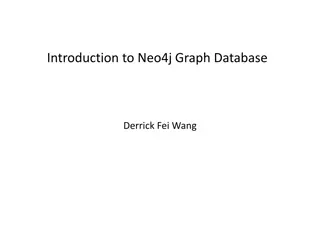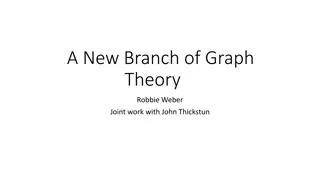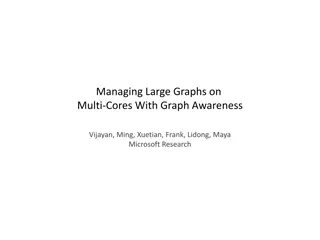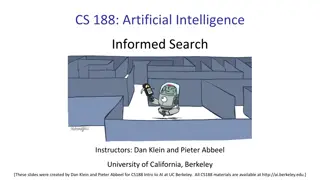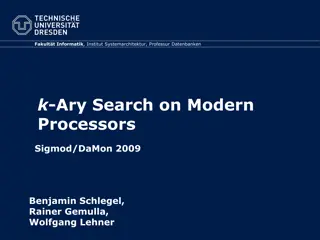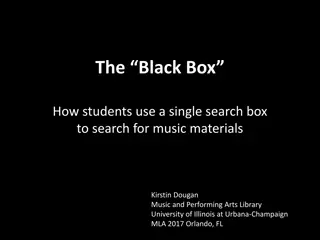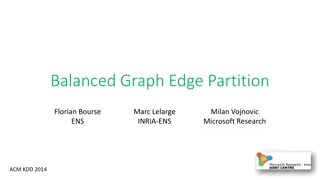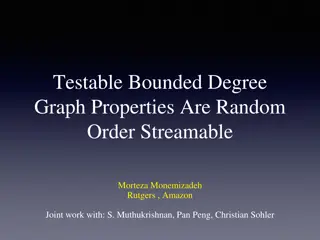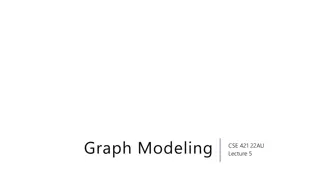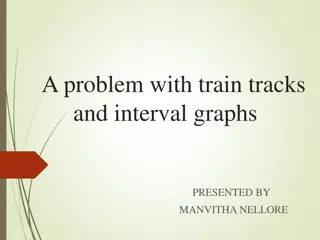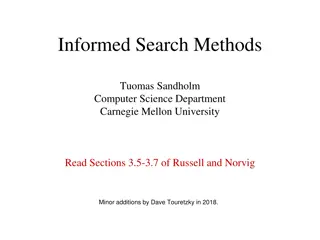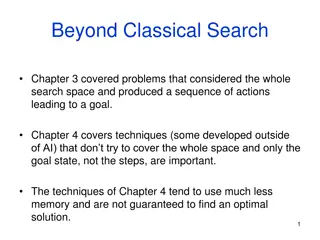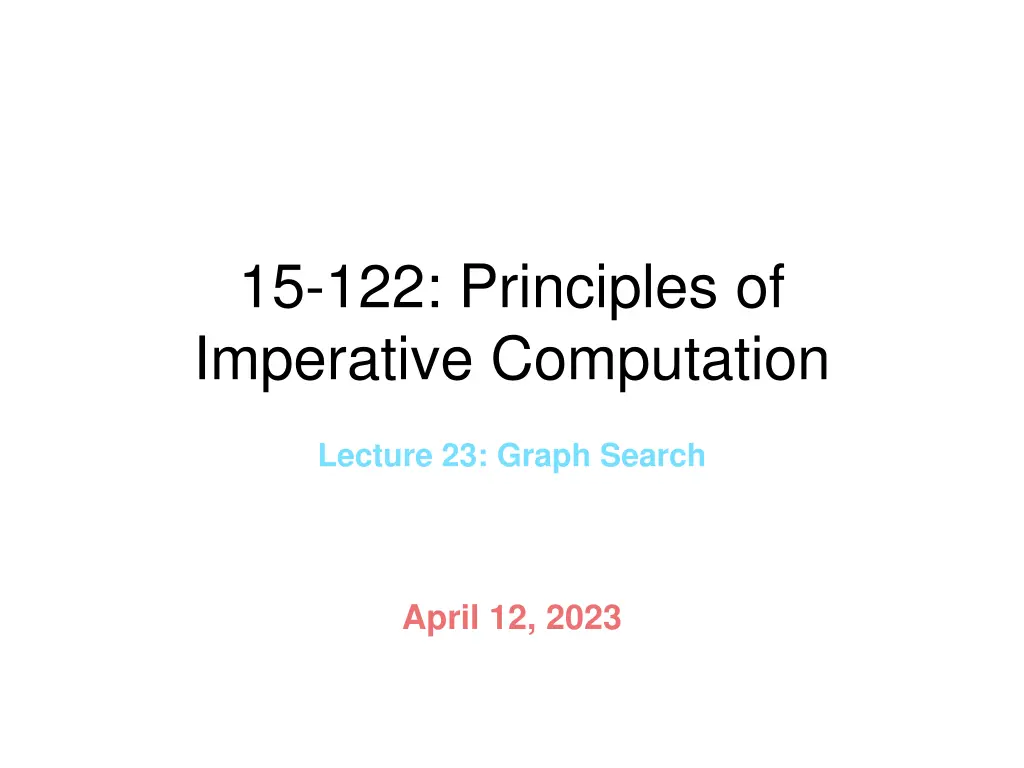
Graph Search and Connectivity in Imperative Computation Lecture
Explore graph search algorithms and connectivity concepts in imperative computation through a detailed lecture covering topics like depth-first search, breadth-first search, adjacency matrix, and adjacency list implementations. Learn about the efficiency and space considerations for dense and sparse graphs. Get ready for your final exam and review key graph theory principles.
Uploaded on | 3 Views
Download Presentation

Please find below an Image/Link to download the presentation.
The content on the website is provided AS IS for your information and personal use only. It may not be sold, licensed, or shared on other websites without obtaining consent from the author. If you encounter any issues during the download, it is possible that the publisher has removed the file from their server.
You are allowed to download the files provided on this website for personal or commercial use, subject to the condition that they are used lawfully. All files are the property of their respective owners.
The content on the website is provided AS IS for your information and personal use only. It may not be sold, licensed, or shared on other websites without obtaining consent from the author.
E N D
Presentation Transcript
15-122: Principles of Imperative Computation Lecture 23: Graph Search April 12, 2023
Today Last lecture: Graphs Today s lecture: Review, graph connectivity, depth-first search, breadth-first search, other searches Announcements: C0VM checkpoint is due today by 9PM The final exam is on Sunday, April 30 from 8:30AM to 11:30AM in Room 2163 1
graph.h typedef unsigned int vertex; typedef struct graph_header *graph_t; Review graph_t graph_new(unsigned int numvert); //@ensures \result != NULL; void graph_free(graph_t G); //@requires G != NULL; 0 3 Graphs o Vertices, edges, neighbors, o Dense, sparse unsigned int graph_size(graph_t G); //@requires G != NULL; 4 bool graph_hasedge(graph_t G, vertex v, vertex w); //@requires G != NULL; //@requires v < graph_size(G) && w < graph_size(G); 1 2 void graph_addedge(graph_t G, vertex v, vertex w); //@requires G != NULL; //@requires v < graph_size(G) && w < graph_size(G); //@requires v != w && !graph_hasedge(G, v, w); 0 1 2 3 4 Adjacency matrix implementation 0 1 2 typedef struct neighbor_header *neighbors_t; 3 4 neighbors_t graph_get_neighbors(graph_t G, vertex v); //@requires G != NULL && v < graph_size(G); //@ensures \result != NULL; Adjacency list implementation 0 1 4 bool graph_hasmore_neighbors(neighbors_t nbors); //@requires nbors != NULL; 1 0 2 4 vertex graph_next_neighbor(neighbors_t nbors); //@requires nbors != NULL; //@requires graph_hasmore_neighbors(nbors); //@ensures is_vertex(\result); 2 1 4 3 3 2 4 0 1 2 void graph_free_neighbors(neighbors_t nbors); //@requires nbors != NULL; 3
Review Adjacency list Adjacency matrix Costs are similar for dense graphs Space O(v + e) O(v2) graph_new O(v) O(v2) graph_free O(v + e) O(1) AL is more space- efficient for sparse graphs o very common graphs e O(v) it typical graph_size O(1) O(1) graph_hasedge O(min(v,e)) O(1) graph_addedge O(1) O(1) graph_get_neighbors O(1) O(v) graph_hasmore_neighbors O(1) O(1) graph_next_neighbor O(1) O(1) graph_free_neighbors O(1) O(min(v,e)) Assuming the neighbors are represented as a linked list represented as a linked list Assuming the neighbors are 4
Review Typical function that traverses a graph o go over most vertices and edges Cost Tally void graph_print(graph_t G) { for (vertex v = 0; v < graph_size(G); v++) { printf("Vertices connected to %u: ", v); neighbors_t nbors = graph_get_neighbors(G, v); while (graph_hasmore_neighbors(nbors)) { vertex w = graph_next_neighbor(nbors); printf(" %u,", w); } graph_free_neighbors(nbors); printf("\n"); } } v times O(1) O(1) O(v) O(v) O(e) altogether O(v + e) O(1) O(v + e) O(1) O(v + e) o Adjacency list: O(v + e) o Adjacency matrix: O(v2) AL is much better for sparse graphs 5
Solving Lightsout Find a sequence of moves from the given configuration to the solved configuration o a path in the lightsout graph Start Here s a path between them: Target 7
Getting Directions Boston Find a sequence of roads from one city to another o a path in the road graph Erie Detroit Indianapolis Columbus Fort Worth Atlanta Juarez Houston Galveston 8
Getting Introduced Find a series of people to get introduced to someone o a path in the contacts graph E 9
Connected Vertices A path is a sequence of vertices linked by edges o 0-4-5-1 is a path between 0 and 1 0 1 2 3 4 5 6 7 Two vertices are connected if there is a path between them o 0 and 1 are connected o 0 and 7 are not connected If v1 and v2 are connected, then v2 is reachable from v1 A connected component is a maximal set of vertices that are connected o this graph has two connected components 0 1 2 3 4 5 6 7 10
Checking Reachability How do we check if two vertices are connected? o graph_hasedge only tells us if they are directly connected by an edge o We want to develop a general algorithm to check reachability then we can use it to check reachability in any domain to check if lightsout is solvable from a given board to figure out if there are roads between two cities to know if there is any social connection between two people The rest of this lecture 0 1 2 3 4 5 6 7 11
Finding Paths How do we find a path between two vertices? what is a solution to lightsout from a given board? what roads are there between two cities? what series of people can get me introduced to person X? o an algorithm that checks reachability can be instrumented to report a path between the two vertices We will limit ourselves to reachability A path is a witness that two vertices are connected o Finding a witness is called a search problem o Checking a witness is called a verification problem checking that a witness is valid is often a lot easier than finding a witness This is the basic principle underlying cryptography 12
Checking Reachability This is an inductive definition Let s define reachability mathematically There is a path from start to target if o start == target, or o there is an edge from start to some vertex v and there is a path from v to target base case inductive case start target start target 0 3 0 3 4 4 v 1 2 1 2 There is a path from 0 to 0 There is a path from 0 to 3 13
Implementing the Definition We can immediately transcribe this inductive definition into a recursive client-side function There is a path from start to target if o start == target, or o there is an edge from start to some vertex v and there is a path from v to target bool naive_dfs(graph_t G, vertex start, vertex target) { REQUIRES(G != NULL); REQUIRES(start < graph_size(G) && target < graph_size(G)); Contracts // there is a path from start to target if // target == start, or // there is an edge from start to ... // ... some vertex v // ... and there is a path from v to target } 15
graph.h typedef unsigned int vertex; typedef struct graph_header *graph_t; Implementing the Definition graph_t graph_new(unsigned int numvert); //@ensures \result != NULL; void graph_free(graph_t G); //@requires G != NULL; bool naive_dfs(graph_t G, vertex start, vertex target) { REQUIRES(G != NULL); REQUIRES(start < graph_size(G) && target < graph_size(G)); printf(" Visiting %u\n", start); unsigned int graph_size(graph_t G); //@requires G != NULL; bool graph_hasedge(graph_t G, vertex v, vertex w); //@requires G != NULL; //@requires v < graph_size(G) && w < graph_size(G); void graph_addedge(graph_t G, vertex v, vertex w); //@requires G != NULL; //@requires v < graph_size(G) && w < graph_size(G); //@requires v != w && !graph_hasedge(G, v, w); // there is a path from start to target if // target == start, or if (target == start) return true; // there is an edge from start to ... neighbors_t nbors = graph_get_neighbors(G, start); while (graph_hasmore_neighbors(nbors)) { // ... some vertex v vertex v = graph_next_neighbor(nbors); // ... and there is a path from v to target if (naive_dfs(G, v, target)) { graph_free_neighbors(nbors); return true; } } graph_free_neighbors(nbors); return false; } 16 typedef struct neighbor_header *neighbors_t; neighbors_t graph_get_neighbors(graph_t G, vertex v); //@requires G != NULL && v < graph_size(G); //@ensures \result != NULL; bool graph_hasmore_neighbors(neighbors_t nbors); //@requires nbors != NULL; vertex graph_next_neighbor(neighbors_t nbors); //@requires nbors != NULL; //@requires graph_hasmore_neighbors(nbors); //@ensures is_vertex(\result); void graph_free_neighbors(neighbors_t nbors); //@requires nbors != NULL;
Implementing the Definition It has the same structure as graph_print bool naive_dfs(graph_t G, vertex start, vertex target) { REQUIRES(G != NULL); REQUIRES(start < graph_size(G) && target < graph_size(G)); printf(" Visiting %u\n", start); // there is a path from start to target if // target == start, or if (target == start) return true; // there is an edge from start to ... neighbors_t nbors = graph_get_neighbors(G, start); while (graph_hasmore_neighbors(nbors)) { // ... some vertex v vertex v = graph_next_neighbor(nbors); // ... and there is a path from v to target if (naive_dfs(G, v, target)) { graph_free_neighbors(nbors); return true; } } graph_free_neighbors(nbors); return false; } 17 void graph_print(graph_t G) { for (vertex v = 0; v < graph_size(G); v++) { printf("Vertices connected to %u: ", v); neighbors_t nbors = graph_get_neighbors(G, v); while (graph_hasmore_neighbors(nbors)) { vertex w = graph_next_neighbor(nbors); printf(" %u,", w); } graph_free_neighbors(nbors); printf("\n"); } } o the outer loop is replaced with recursion
Does it Work? target start 0 3 Let s check there is a path from 3 to 0 4 Assume the neighbors are returned from smallest to biggest start 3 2 1 0 target 0 0 0 0 nbors 2 1, 3, 4 0, 2, 4 1 2 bool naive_dfs(graph_t G, vertex start, vertex target) { REQUIRES(G != NULL); REQUIRES(start < graph_size(G) && target < graph_size(G)); printf(" Visiting %u\n", start); // there is a path from start to target if // target == start, or if (target == start) return true; // there is an edge from start to ... neighbors_t nbors = graph_get_neighbors(G, start); while (graph_hasmore_neighbors(nbors)) { // ... some vertex v vertex v = graph_next_neighbor(nbors); // ... and there is a path from v to target if (naive_dfs(G, v, target)) { graph_free_neighbors(nbors); return true; } } graph_free_neighbors(nbors); return false; } Let s run it Linux Terminal # gcc lib/*.c connected.c main.c # ./a.out 3 0 Visiting 3 Visiting 2 Visiting 1 Visiting 0 Reachable from to Looks good 18
Does it Always Work? start target 0 3 Let s check there is a path from 0 to 3 4 start 0 1 0 1 (this is not promising) target 3 3 3 3 nbors 1, 4 0, 2, 4 1, 4 0, 2, 4 1 2 bool naive_dfs(graph_t G, vertex start, vertex target) { REQUIRES(G != NULL); REQUIRES(start < graph_size(G) && target < graph_size(G)); printf(" Visiting %u\n", start); // there is a path from start to target if // target == start, or if (target == start) return true; // there is an edge from start to ... neighbors_t nbors = graph_get_neighbors(G, start); while (graph_hasmore_neighbors(nbors)) { // ... some vertex v vertex v = graph_next_neighbor(nbors); // ... and there is a path from v to target if (naive_dfs(G, v, target)) { graph_free_neighbors(nbors); return true; } } graph_free_neighbors(nbors); return false; } Let s run it Linux Terminal # gcc lib/*.c connected.c main.c # ./a.out 0 3 Visiting 0 Visiting 1 Visiting 0 runs forever! 19
It does not Work Either the definition is wrong or the code is wrong There is a path from start to target if o start == target, or o there is an edge from start to some vertex v and there is a path from v to target Definition o it magically picks the right neighbor v if there is one the magic of there is bool naive_dfs(graph_t G, vertex start, vertex target) { REQUIRES(G != NULL); REQUIRES(start < graph_size(G) && target < graph_si printf(" Visiting %u\n", start); // there is a path from start to target if // target == start, or if (target == start) return true; // there is an edge from start to ... neighbors_t nbors = graph_get_neighbors(G, start); while (graph_hasmore_neighbors(nbors)) { // ... some vertex v vertex v = graph_next_neighbor(nbors); // ... and there is a path from v to target if (naive_dfs(G, v, target)) { graph_free_neighbors(nbors); return true; } } graph_free_neighbors(nbors); return false; } The definition is fine Code o it must examine the neighbors in some order the first v may not be the right one 20
Why doesnt it Work? start target The code examines the neighbors in some order o it always starts with the same v the first neighbor o even if it has been examined before 0 3 4 1 2 start 0 1 0 1 target 3 3 3 3 nbors 1, 4 0, 2, 4 1, 4 0, 2, 4 The code will never visit the second neighbor (if there is one) it charges ahead with the first neighbor, always o if there is a path by only examining first neighbors, it will find it o if the path involves some other neighbor, it won t 21
Fixing the Code Problems: the code examines the same neighbors over and over Solution: mark vertices that are being examined o only examine a vertex if it is unmarked o mark it right away How to mark vertices? o carry around an array of booleans true = marked false = unmarked We could use any implementation of sets, e.g., hash sets 23
Fixing the Code bool dfs_helper(graph_t G, bool *mark, vertex start, vertex target) { REQUIRES(G != NULL); REQUIRES(start < graph_size(G) && target < graph_size(G)); REQUIRES(!mark[start]); Carry around an array of booleans Only run if start is unmarked mark[start] = true; printf(" Visiting %u\n", start); // there is a path from start to target if // target == start, or if (target == start) return true; // there is an edge from start to ... neighbors_t nbors = graph_get_neighbors(G, start); while (graph_hasmore_neighbors(nbors)) { // ... some vertex v vertex v = graph_next_neighbor(nbors); // ... and there is a path from v to target if (!mark[v] && dfs_helper(G, mark, v, target)) { graph_free_neighbors(nbors); return true; } } graph_free_neighbors(nbors); return false; } Mark it right away Only examine a neighbor if it s unmarked o we need to guard the recursive call 24
Fixing the Code We have modified the prototype of the function o but the client should not have to deal with the added details o export a wrapper instead of dsf_helper Create the mark array: calloc initializes all positions to false bool dfs (graph_t G, vertex start, vertex target) { REQUIRES(G != NULL); REQUIRES(start < graph_size(G) && target < graph_size(G)); bool *mark = xcalloc(graph_size(G), sizeof(bool)); bool connected = dfs_helper(G, mark, start, target); free(mark); return connected; } We must free mark since we calloc ated it 25
An Alternative Wrapper We can also use a stack-allocated array for mark bool dfs(graph_t G, vertex start, vertex target) { REQUIRES(G != NULL); REQUIRES(start < graph_size(G) && target < graph_size(G)); Create the a stack allocated array of size graph_size(G) bool mark[graph_size(G)]; for (unsigned int v = 0; v < graph_size(G); v++) mark[v] = false; We need to initialize it explicitly return dfs_helper(G, mark, start, target); } But we don t need to free it Is this version preferable? o stack space is limited o for a large graph, the stack may not be big enough stack overflow 26
Does it Work? 0 3 start target 4 Let s check there is a path from 0 to 3 1 2 start 0 1 2 3 target 3 3 3 3 nbors 1, 4 0, 2, 4 1, 3, 4 marked 0 0, 1 0, 1, 2 0 3 target 4 1 2 0 3 target Let s run it 4 Linux Terminal 1 2 # gcc lib/*.c connected.c main.c # ./a.out 0 3 Visiting 0 Visiting 1 Visiting 2 Visiting 3 Reachable 0 3 target 4 1 2 27
Backtracking Let s check there is a path from 2 to 3 start 2 1 0 4 3 target 3 3 3 3 3 nbors 1, 3, 4 0, 2, 4 1, 4 0, 1, 2 marked 2 1, 2 0, 1, 2 0, 1, 2, 4 3 4 and all the neighbors of 4 are marked We backtrack to a vertex that has a still unmarked neighbor continue from it target target target target target 0 3 0 3 0 3 0 3 0 3 4 4 4 4 4 start 1 2 1 2 1 2 1 2 1 2 28
start 2 1 0 4 3 target 3 3 3 3 3 nbors 1, 3, 4 0, 2, 4 1, 4 0, 1, 2 marked 2 1, 2 0, 1, 2 0, 1, 2, 4 Backtracking We backtrack to a vertex that has a still unmarked neighbor and continue from it This is achieved by returning false from the recursive call o the caller will then try the next unmarked neighbor Let s run it while (graph_hasmore_neighbors(nbors)) { // ... some vertex v vertex v = graph_next_neighbor(nbors); // ... and there is a path from v to target if (!mark[v] && dfs_helper(G, mark v, target)) { graph_free_neighbors(nbors); return true; } } graph_free_neighbors(nbors); return false; } Linux Terminal # gcc lib/*.c connected.c main.c # ./a.out 2 3 Visiting 2 Visiting 1 Visiting 0 Visiting 4 Visiting 3 Reachable 29
graph_size O(1) Complexity of dfs Let s call dfs on a graph with o v vertices, o e edges, and o implemented using adjacency lists bool dfs (graph_t G, vertex start, vertex target) { REQUIRES(G != NULL); REQUIRES(start < graph_size(G) && target < graph_size(G)); O(v) bool *mark = xcalloc(graph_size(G), sizeof(bool)); bool connected = dfs_helper(G, mark, start, target); free(mark); return connected; } free has constant cost The cost of dfs is O(v) plus the cost of dfs_helper 30
graph_get_neighbors O(1) graph_hasmore_neighbors O(1) Complexity of dfs_helper graph_next_neighbor O(1) graph_free_neighbors O(1) The body of the loop runs at most 2e times altogether at most 2e calls to graph_next_neighbors e edges from either endpoint each endpoint is examined at most once Just like for graph_print In reality, it s more like min(v,e) There are at most v recursive calls o up to v vertices can be marked bool dfs_helper(graph_t G, bool *mark, vertex start, vertex target) { mark[start] = true; O(1) O(v) if (target == start) return true; O(1) O(v) Every operation costs O(1) neighbors_t nbors = graph_get_neighbors(G, start); while (graph_hasmore_neighbors(nbors)) { vertex v = graph_next_neighbor(nbors); if (!mark[v] && dfs_helper(G, mark, v, target)) { graph_free_neighbors(nbors); return true; } } graph_free_neighbors(nbors); return false; } O(1) O(v) O(1) O(1) O(1) O(1) O(e) dfs_helper has cost O(e + v) O(v + e) altogether O(1) O(v + e) Tally 31
graph_size O(1) graph_get_neighbors O(1) Complexity of dfs graph_hasmore_neighbors O(1) graph_next_neighbor O(1) graph_free_neighbors O(1) Let s call dfs on a graph with v vertices, e edges, and implemented using adjacency lists bool dfs (graph_t G, vertex start, vertex target) { REQUIRES(G != NULL); REQUIRES(start < graph_size(G) && target < graph_size(G)); O(v) bool *mark = xcalloc(graph_size(G), sizeof(bool)); bool connected = dfs_helper(G, mark, start, target); free(mark); return connected; } O(v + e) The cost of dfs is O(v + e) 32
Complexity of dfs For a graph with v vertices and e edges O(v + e) using the adjacency list implementation Holds for both sparse and dense graphs graphs Holds for both sparse and dense O(v2) using the adjacency matrix implementation Exercise AL is more efficient for sparse graphs o the most common kind of graphs Moving forward, we will always assume an adjacency list implementation 33
How does dfs Work? When calling dfs on 0 and 4, it finds the path 0 1 2 4 o it also visits 3 and backtracks start 0 1 2 3 4 target 4 4 4 4 4 nbors 1, 4 0, 2, 4 1, 3, 4 2 marked 0 0, 1 0, 1, 2 0, 1, 2, 3 But there is a much shorter path: 0 4 o dfs does more work than strictly necessary start target target target target target 0 3 0 3 0 3 0 3 0 3 4 4 4 4 4 1 2 1 2 1 2 1 2 1 2 35
How does dfs Work? dfs charges ahead until o it finds the target vertex o or it hits a dead end then it backtracks to the last choice point start 0 1 2 3 4 target 4 4 4 4 4 nbors 1, 4 0, 2, 4 1, 3, 4 2 marked 0 0, 1 0, 1, 2 0, 1, 2, 3 This strategy is called depth-first search DFS start target target target target target 0 3 0 3 0 3 0 3 0 3 4 4 4 4 4 1 2 1 2 1 2 1 2 1 2 36
Breadth-first Search To find the shortest path, we need to explore the graph level by level from the start vertex o first look at the vertices 0 hops away from start, if start == end o then look at the vertices 1 hop away from start o then 2 hops away o then 3 hops away o 4 0 1 2 3 1 1 0 3 0 3 0 3 start target target target 4 4 1 2 1 2 1 2 This strategy is called breadth-first search BFS 37
Breadth-first Search We need to traverse the graph level by level 0 1 2 3 1 1 0 3 0 3 0 3 start target target target 4 4 4 1 2 1 2 1 2 o When we examine 0, we need to remember that we will have to examine 1 and 4 later o When we examine 1, we need to remember we may have to examine 2 later but first we need to look at 4 We need a todo list 38
Breadth-first Search That s what we called todo lists We need a work list 0 1 2 3 1 1 0 3 0 3 0 3 start target target target 4 4 4 1 2 1 2 1 2 We need to traverse the graph level by level o finish examining the current level before starting the next level o we need to retrieve the vertices inserted the longest time ago This work list must be a queue o older nodes need to be visited before newer nodes 39
Breadth-first Search 0 1 2 3 1 1 This work list must be a queue 0 3 0 3 0 3 start target target target 4 4 4 1 2 1 2 1 2 o start with 0 in the queue o at each step, retrieve the next vertex to examine o We mark the vertices so we don t put them in the queue twice either because we examined them already or because they are already in the queue and will be examined later next target 4 4 4 4 queue 0 1, 4 4, 2 marked 0 0, 1, 4 0, 1, 4, 2 0 1 4 40
Implementing BFS We need o a queue where to store the vertices to examine next o a mark array where to track the vertices we know about either already examined or queued up to be examined 41
Implementing BFS For as long as there are vertices still to be processed o retrieve the vertex v inserted in the queue the longest time ago if v is target, we are done there is a path o examine each neighbor w of v if w is unmarked add it to the queue and mark it otherwise ignore w it was already queued up for processing if the queue is empty o there are no vertices left to process o and we have not found a path o we are done there is no path 42
Implementing BFS I Initial setup bool bfs(graph_t G, vertex start, vertex target) { REQUIRES(G != NULL); REQUIRES(start < graph_size(G) && target < graph_size(G)); If start is target, there is a path if (start == target) return true; // mark is an array containing only start bool *mark = xcalloc(graph_size(G), sizeof(bool)); mark[start] = true; calloc initializes every vertex as unmarked but we want start to be marked // Q initially is a queue containing only start queue_t Q = queue_new(); enq(Q, start); Initially only start is in the queue 43
Implementing BFS II Traversing the graph for as long as there are vertices to process while (!queue_empty(Q)) { vertex v = deq(Q); printf(" Visiting %u\n", v); if (v == target) { queue_free(Q); free(mark); return true; } neighbors_t nbors = graph_get_neighbors(G, v); while (graph_hasmore_neighbors(nbors)) { vertex w = graph_next_neighbor(nbors); if (!mark[w]) { mark[w] = true; enq(Q, w); } } graph_free_neighbors(nbors); } v is the next vertex to process If v is target, there is a path clean up before returning examine each neighbor w of v if w is unmarked mark it and add it to the queue we are done with the neighbors of v 44
Implementing BFS III Giving up while (!queue_empty(Q)) { } ASSERT(queue_empty(Q)); queue_free(Q); free(mark); return false; } If there are no more vertices to process there is no path clean up before returning 45
bool bfs(graph_t G, vertex start, vertex target) { REQUIRES(G != NULL); REQUIRES(start < graph_size(G) && target < graph_size(G)); Implementing BFS if (start == target) return true; // mark is an array containing only start bool *mark = xcalloc(graph_size(G), sizeof(bool)); mark[start] = true; Here s the overall code // Q is a queue containing only start initially queue_t Q = queue_new(); enq(Q, start); while (!queue_empty(Q)) { // v is the next vertex to process vertex v = deq(Q); printf(" Visiting %u\n", v); if (v == target) { // if v is target return true queue_free(Q); free(mark); return true; } // for every neighbor w of v neighbors_t nbors = graph_get_neighbors(G, v); while (graph_hasmore_neighbors(nbors)) { vertex w = graph_next_neighbor(nbors); if (!mark[w]) { // if w is not already marked mark[w] = true; // mark it enq(Q, w); // enqueue it onto the queue } } graph_free_neighbors(nbors); } ASSERT(queue_empty(Q)); queue_free(Q); free(mark); return false; } 46
bool bfs(graph_t G, vertex start, vertex target) { REQUIRES(G != NULL); REQUIRES(start < graph_size(G) && target < graph_size(G)); Implementing BFS if (start == target) return true; // mark is an array containing only start bool *mark = xcalloc(graph_size(G), sizeof(bool)); mark[start] = true; This code is iterative o DFS earlier was recursive // Q is a queue containing only start initially queue_t Q = queue_new(); enq(Q, start); while (!queue_empty(Q)) { // v is the next vertex to process vertex v = deq(Q); printf(" Visiting %u\n", v); if (v == target) { // if v is target return true queue_free(Q); free(mark); return true; } // for every neighbor w of v neighbors_t nbors = graph_get_neighbors(G, v); while (graph_hasmore_neighbors(nbors)) { vertex w = graph_next_neighbor(nbors); if (!mark[w]) { // if w is not already marked mark[w] = true; // mark it enq(Q, w); // enqueue it onto the queue } } graph_free_neighbors(nbors); } ASSERT(queue_empty(Q)); queue_free(Q); free(mark); return false; } The code structure is the same as graph_print void graph_print(graph_t G) { for (vertex v = 0; v < graph_size(G); v++) { printf("Vertices connected to %u: ", v); neighbors_t nbors = graph_get_neighbors(G, v); while (graph_hasmore_neighbors(nbors)) { vertex w = graph_next_neighbor(nbors); printf(" %u,", w); } graph_free_neighbors(nbors); printf("\n"); } } 47
bool bfs(graph_t G, vertex start, vertex target) { REQUIRES(G != NULL); REQUIRES(start < graph_size(G) && target < graph_size(G)); Implementing BFS if (start == target) return true; O(1) // mark is an array containing only start bool *mark = xcalloc(graph_size(G), sizeof(bool)); mark[start] = true; O(v) The code structure is the same as graph_print o except that we return early if we find a path O(1) // Q is a queue containing only start initially queue_t Q = queue_new(); enq(Q, start); O(1) O(1) v times while (!queue_empty(Q)) { // v is the next vertex to process vertex v = deq(Q); printf(" Visiting %u\n", v); if (v == target) { // if v is target return true queue_free(Q); free(mark); return true; } // for every neighbor w of v neighbors_t nbors = graph_get_neighbors(G, v); while (graph_hasmore_neighbors(nbors)) { vertex w = graph_next_neighbor(nbors); if (!mark[w]) { // if w is not already marked mark[w] = true; // mark it enq(Q, w); // enqueue it onto the queue } } graph_free_neighbors(nbors); } ASSERT(queue_empty(Q)); queue_free(Q); free(mark); return false; } The complexity of bfs is o O(v + e) with adjacency lists o O(v2) with adjacency matrices O(1) same as dfs O(e) altogether O(1) O(1) 48
bool bfs(graph_t G, vertex start, vertex target) { REQUIRES(G != NULL); REQUIRES(start < graph_size(G) && target < graph_size(G)); Correctness if (start == target) return true; // mark is an array containing only start bool *mark = xcalloc(graph_size(G), sizeof(bool)); mark[start] = true; bfs is correct if it returns o true when there is a path from start to target o false when there is no path from start to target // Q is a queue containing only start initially queue_t Q = queue_new(); enq(Q, start); while (!queue_empty(Q)) { // v is the next vertex to process vertex v = deq(Q); printf(" Visiting %u\n", v); if (v == target) { // if v is target return true queue_free(Q); free(mark); return true; } // for every neighbor w of v neighbors_t nbors = graph_get_neighbors(G, v); while (graph_hasmore_neighbors(nbors)) { vertex w = graph_next_neighbor(nbors); if (!mark[w]) { // if w is not already marked mark[w] = true; // mark it enq(Q, w); // enqueue it onto the queue } } graph_free_neighbors(nbors); } ASSERT(queue_empty(Q)); queue_free(Q); free(mark); return false; } It returns in three places 49



